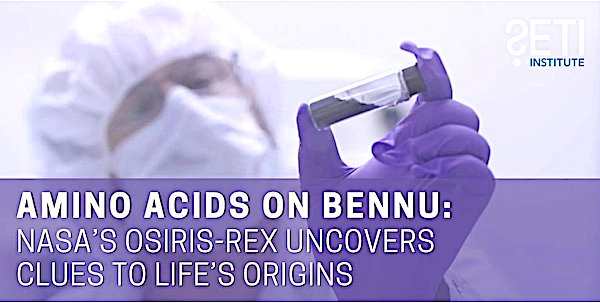
NASA’s OSIRIS-REx (Origins, Spectral Interpretation, Resource Identification, and Security-Regolith Explorer) mission has detected amino acids in the largest asteroid sample ever collected in space, asteroid Bennu. This discovery offers key insights into the early solar system and the origins of life.
In the latest SETI Live, Communications Specialist Beth Johnson and NASA scientist Danny Glavin discuss these findings and their implications for the development of life.
OSIRIS-REx: NASA’s Historic Mission
OSIRIS-REx, the first US mission to collect a sample from an asteroid, launched in 2016. In 2020, it gathered a sample from Bennu and returned it to Earth in 2023. These uncontaminated samples help scientists study the composition of space materials, providing insights into the early solar system and confirming their extraterrestrial origins.
Key Discoveries: Amino Acids and DNA Components
The team found 14 of the 20 amino acids used in Earth’s proteins. These molecules are essential for life, forming proteins and enzymes that drive biological processes. Even more remarkably, all five DNA and RNA nucleobases—adenine, cytosine, thymine, guanine, and uracil—were detected in the sample, along with phosphate compounds crucial for genetic material.
Danny Glavin reviewed previous studies on meteorites that detected amino acids and states that contamination has always been a concern. Bennu’s material, on the other hand, is pristine, making this the first confirmed extraterrestrial detection of these biological building blocks. These findings suggest that the chemistry necessary for life occurred in space even before Earth formed.
Bennu’s Samples: Evidence of Extraterrestrial Chemistry
To confirm Bennu’s amino acids were not contaminated by Earth, scientists analyzed their chirality (handedness). Life on Earth exclusively uses left-handed amino acids, while non-biological processes produce an equal mix of left and right-handed forms.
Bennu’s samples contained a balanced mixture, proving these amino acids formed naturally in space rather than from living organisms. This confirms their extraterrestrial origin and supports the idea that life’s building blocks were widespread in the early solar system.
What This Means for Life Beyond Earth
Bennu’s findings support the idea that organic molecules were widespread in the early solar system and could have been delivered to Earth and Mars via asteroids. Life’s building blocks in these environments increase the likelihood that life could have emerged elsewhere in the cosmos.
Beth Johnson emphasized that these discoveries fuel the search for extraterrestrial life. She also highlighted upcoming missions, such as Mars Sample Return, which could provide further clues about the spread of organic molecules in the solar system.
Further analysis of Bennu’s sample is ongoing, and more discoveries are expected. Meanwhile, OSIRIS-REx has been renamed OSIRIS-APEX and is now en route to study the asteroid Apophis. The search for life’s origins continues!
